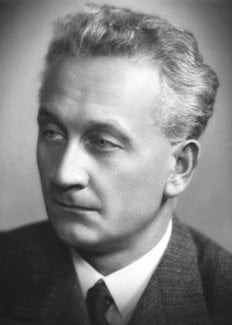Albert Szent-Györgyi
Biographical

Albert von Szent-Györgyi was born in Budapest on September 16, 1893, the son of Nicolaus von Szent-Györgyi, a great landed proprietor and Josefine, whose father, Joseph Lenhossék, and brother Michael were both Professors of Anatomy in the University of Budapest. He matriculated in 1911 and entered his uncle’s laboratory where he studied until the outbreak of World War I when he was mobilized. He served on the Italian and Russian fronts, gaining the Silver Medal for Valour, and he was discharged in 1917 after being wounded in action. He completed his studies in Budapest and then worked successively with the pharmacologist, G. Mansfeld at Pozsony, with Armin von Tschermak at Prague, where he studied electrophysiology, and with L. Michaelis in Berlin, before he went to Hamburg for a two-year course in physical chemistry at the Institute for Tropical Hygiene.
In 1920 he became an assistant at the University Institute of Pharmacology in Leiden and from 1922 to 1926 he worked with H. J. Hamburger at the Physiology Institute, Groningen, The Netherlands. In 1927 he went to Cambridge as a Rockefeller Fellow, working under F. G. Hopkins, and spent one year at the Mayo Foundation, Rochester, Minnesota, before returning to Cambridge. In 1930 he obtained the Chair of Medical Chemistry at the University of Szeged and in 1935 he also took the Chair in Organic Chemistry. At the end of World War II, he took the Chair of Medical Chemistry at Budapest and in 1947 he left Hungary to settle in the United States where he is Director of Research, Institute of Muscle Research, Woods Hole, Massachusetts.
Szent-Györgyi’s early researches at Groningen concerned the chemistry of cell respiration. He described the interdependence of oxygen and hydrogen activation and made his first observations on co-dehydrases and the polyphenol oxidase systems of plants. He also demonstrated the existence of a reducing substance in plant and animal tissues. At Cambridge and during his early spell in the United States, he isolated from adrenals this reducing substance, which is now known as ascorbic acid. Returning to Cambridge in 1929, he later described the pharmacological activity of the nucleotides with Drury.
On his return to Hungary, he noted the anti-scorbutic activity of ascorbic acid and discovered that paprika (Capsicum annuum) was a rich source of vitamin C. His persistent studies of biological oxidation led to the recognition of the catalytic function of the C4-dicarboxylic acids, the discovery of «cytoflav» (flavin) and a recognition of the biological activity and probable vitamin nature of flavanone (vitamin P).
In 1938 he commenced work on muscle research and quickly discovered the proteins actin and myosin and their complex. This led to a reproduction of the fundamental reaction of muscle contraction which formed the foundation of muscle research in the following decades. The preservation of biological material in glycerine, which has had extensive application including agricultural use in the preservation of sperm, has resulted from his more recent work. He has also developed the use of rabbit psoas muscle as an experimental material, published theories on the problems of energetics and investigated the regulation of growth and cell membrane potential, and the hormonal function of the thymus gland.
Szent-Györgyi, a member of many scientific societies, is a Past President of the Academy of Sciences, Budapest, and a Vice-President of the National Academy, Budapest. He was Visiting Professor, Harvard University in 1936 and Franchi Professor, University of Liège, 1938. He received the Cameron Prize (Edinburgh) in 1946 and the Lasker Award in 1954. His many publications include Oxidation, Fermentation, Vitamins, Health and Disease (1939); Muscular Contraction (1947); The Nature of Life (1947); Contraction in Body and Heart Muscle (1953); and Bioenergetics (1957).
Szent-Györgyi married Cornelia Demény, daughter of the Hungarian Postmaster-General, in 1917: they have one daughter. During the 1930’s he was actively anti-Nazi and during World War II he became a Swedish citizen – he was given extensive help by the Swedish Embassy in Budapest. In 1941, he married Marta Borbiro, a co-worker at Woods Hole.
He is interested in sport of all kinds, his favourites being sailing and alpinism.
This autobiography/biography was written at the time of the award and first published in the book series Les Prix Nobel. It was later edited and republished in Nobel Lectures. To cite this document, always state the source as shown above.
Albert Szent-Györgyi died on 22 October 1986.
Nobel Prizes and laureates
Six prizes were awarded for achievements that have conferred the greatest benefit to humankind. The 14 laureates' work and discoveries range from quantum tunnelling to promoting democratic rights.
See them all presented here.
